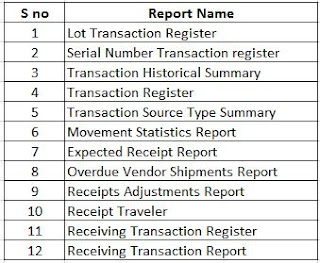Oracle SCM Functional
Interview Questions & Answers - Inventory Module – Part IX
What is the
difference between Fixed Lot Multiplier and Fixed Order Quantity?
Fixed Order Quantity:
Enter the quantity used to modify the size of planned order quantities
or repetitive daily rates. When net requirements fall short of the fixed order
quantity, the planning process suggests the fixed order quantity. When net
requirements exceed the fixed order quantity, the planning process suggests
multiple orders for the fixed order quantity.
For discrete items, use this attribute to define a fixed production or
purchasing quantity. For repetitive items, use this attribute to define a fixed
production rate. For example, if your suppliers can provide the item in full
truckload quantities only, enter the full truckload quantity as the fixed order
quantity. (This field will come under general planning tab of item master
screen)
Fixed Lot Multiplier:
Enter the fixed lot multiple quantity or repetitive rate (units per
day). Planning algorithms (reorder point, min–max, MPS, and MRP) use this to
modify the size of planned order quantities or repetitive daily rates.
When net requirements fall short of the fixed lot size multiplier
quantity, planning algorithms suggest a single order for the fixed lot size
multiplier quantity. When net requirements exceed the fixed lot size multiplier
quantity, planning algorithms suggest a single order that is a multiple of the
fixed lot size multiplier. (This field will come under general planning tab of
item master screen).
What is the
difference between ‘Shrinkage Rate’ and Yield % mentioned in the BOM?
Shrinkage Rate:
It is the expected loss of Finished Goods on prolonged storage. (May
be some weight losses due to drying etc.)
Yield %:
It represents the expected losses of components, used to manufacture
an item, occurring during the manufacturing process.
The same item can have different Yield % in different Bill, but the
Shrinkage % remains the same.
The Item
Attribute, ‘Acceptable Days Early’ is applicable to items meant for Discrete
Jobs or Repetitive Schedules?
The said attribute is applicable only for Discrete Jobs. Planning
suggests a rescheduling only if the rescheduling is required earlier than the
number of days mentioned here
The item
Attribute, ‘Overrun percentage’, ‘Acceptable Rate Increase’ and ‘Acceptable
Rate Decrease’ are used for what?
All these item attributes mentioned above are used only for
Repetitively Planned items. The planning process suggests a new daily rate if
the current rate exceeds the suggested rate by more than the acceptable overrun
amount.
Acceptable Rate Increase and Acceptable Rate Decrease are the
tolerance for the daily rates that planning process has to confine while
suggesting new daily rates. Or in other words, the planning process can’t
suggest any new rate beyond the limits of the acceptable rate increase and
acceptable rate decrease.
How will
you ensure that a Customer order is not placed on an item, which is at the
developing stage?
Set the item attribute, ‘Customer Orders Enabled’ to No.
What is
Transaction Source Type?
A Transaction Source Type is the type of entity against which Oracle
Inventory charges a transaction. Along with a transaction action, it uniquely
identifies the type of transaction we perform.
What is
Transaction Type?
A Transaction Type is a combination of Transaction Type Source and a
Transaction Action. It is used to classify a particular transaction for
reporting and querying purpose.
While doing
transaction in Inventory, (Misc. Receipt / Issue, Subinventory Transfer,
Inter-Org Transfer etc) what date we can enter as the transaction date is
governed by what?
It is governed by the profile option ‘INV: Transaction Date
Validation’.
The option available for this profile are:
1. Allow date in any open
period.
2. Do not allow past date.
3. Do not allow date in past
period.
4. Provide warning when date
is in past period.
How will
you remove transaction details permanently from the database tables?
Navigation:
India Local Inventory Responsibility > Oracle Inventory > Transaction
> Purge
Type: Request
Name: Transaction Purge
Parameter: Purge Date & Purge Name.
Note: Inventory does not purge transaction in an open
period.
What are
the Reports available on Transactions?
Few reports available on transactions:
Which are
the combination results of ‘Content Scope’ and ‘Valuation Scope’ in an ABC
Compile?
The combination results of ‘Content Scope’ and ‘Valuation Scope’ in an
ABC Compile?
Which are
the criteria used in an ABC Compile?
The Criteria used in ABC Compile are:
Can Cycle
Counting and Physical Inventory go side by side?
Yes
What are
the Cycle Count Reports?
Reference:
Collected from various web sources.
Please do refer below links for Oracle SCM Functional
interview questions & Answers on inventory module.




Good Blog, thanks for sharing this information.
ReplyDeleteOracle Fusion SCM Online Training